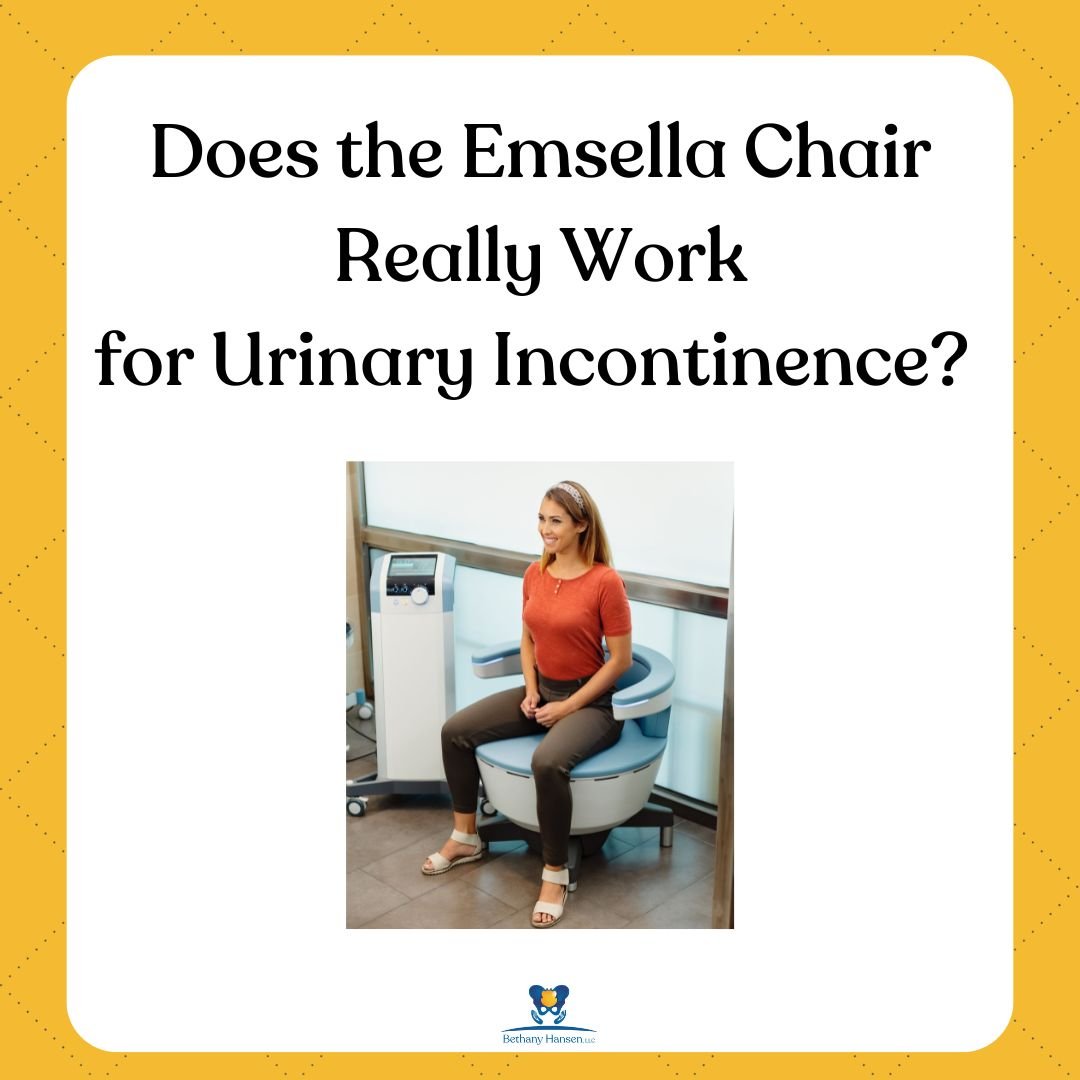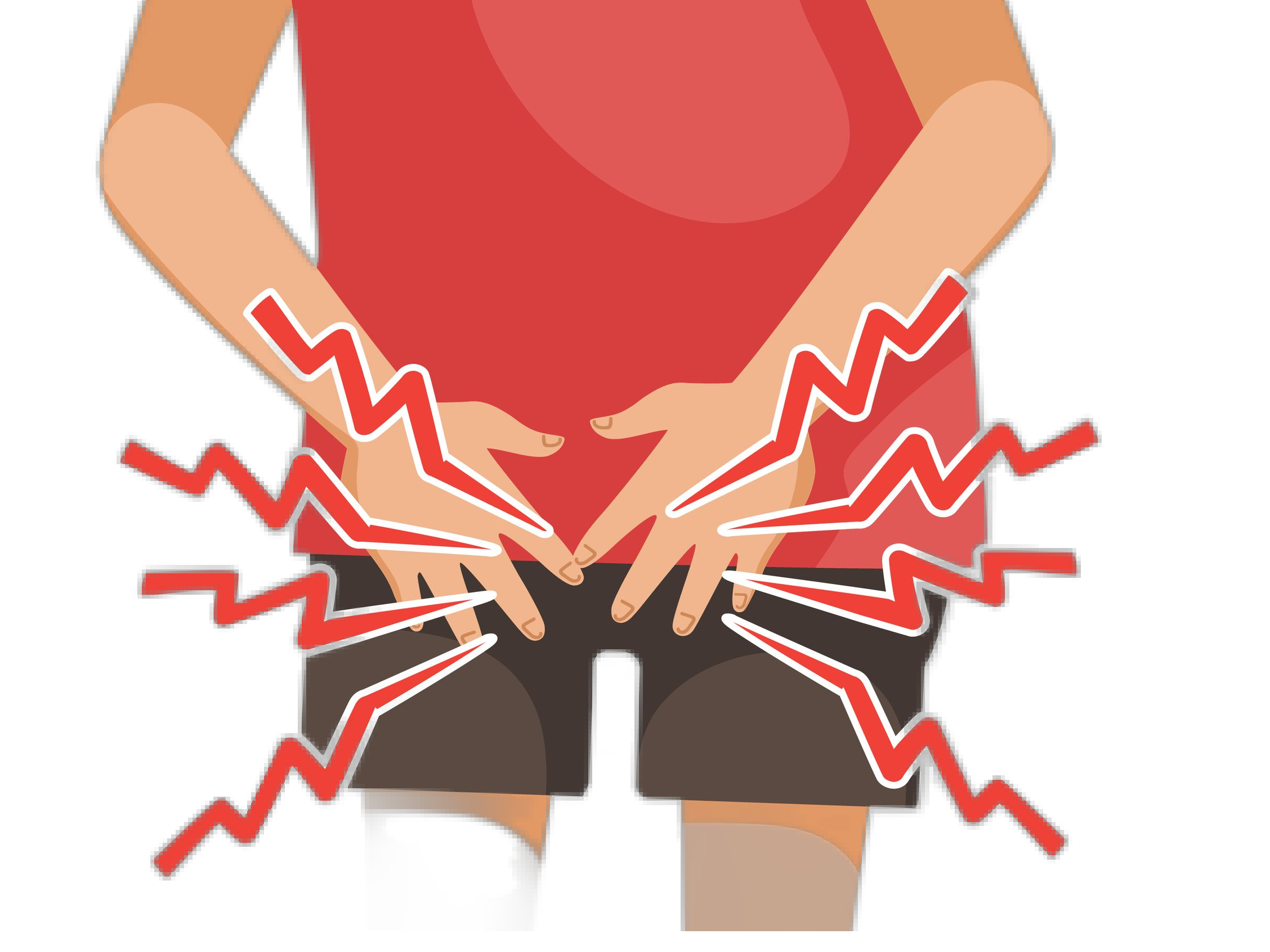Does the Emsella Chair Really Work for Urinary Incontinence?
When I first heard about the popularity of the Emsella chair, I was surprised. These types of devices have been around for awhile, seem to wax and wane in popularity, and show up in different forms. Does anyone remember the abdominal belts of the early 2000s that used electric stim to contract abdominal muscles and was supposed to give you a 6-pack without any exercise?
Yeah, that didn’t work.
But lately, I keep hearing about different devices - chairs, shorts, leggings, etc., all supposed to cure urinary incontinence, bladder urgency and frequency, improve your sex life, etc.
At first, I laughed. Haven’t we been through this before? Then I realized just how great these companies are at marketing to doctors and patients, and I stopped laughing.
So here is what we know: There have been many studies looking at the use of electric stimulation (e-stim) and stress urinary incontinence. These include ones using internal vaginal probes and external electrode placement to deliver the electric stimulation and they vary in: treatment duration, frequency, number of weeks treatment was implemented, short and long-term effects, and use of a control group (or not).
Here is a summary of some data (stay with me here, I’m gonna try not to put you to sleep!):
The systematic review and meta-analysis of 9 randomized controlled trials (RTCs) by Han et al. from 2021 looked at e-stim with non-implated devices (vaginal probes and external electrodes) for stress urinary incontinence (SUI) in women. They concluded, “It appears to provide only short-term reduction in urine leakage and long-term reduction in frequency of incontinence episodes.” They also mentioned limitations due to the lack of quality and quantity of randomized control trials available.
So, not a great start.
As far as attempting to manage SUI with an e-stim “product”, one study in 2019 by Kolb et al. looked at external e-stim electrodes placed in shorts, called Elitone.
Improvement, on average, was going from self-reported 1.84 leaks/day to 0.58 leaks per day, increased quality of life score from 70.3 to 84.8, and decreased pad use from 1.8 to 0.8.
Although it reported statistically significant (stat sig) improvement, the study only included 20 people, had no control group, only 6 weeks of treatment, and no follow-up after 6 weeks.
Still not lookin’ good.
Ok, so let’s look at a different type of stimulation. Electromagnetic stimulation (EMS) has been studied as a treatment for UI since 1998. This is the type of stim used with the modality Emsella. In 2021, Sun et al. did a meta-analysis to evaluate the efficacy of EMS for female SUI. Out of 352 articles reviewed, 6 were included in this study:
Outcome measures varied: episodes of leakage reported, pad tests, perimeter measurements, and various quality of life scores.
While some of the 6 looked promising in some areas, none did any long-term follow-up with only 1 of the 6 assessing 4 months after treatment.
I’m not convinced yet, are you?
Despite not having solid evidence for the efficacy of long-term improvement in any areas of measurement, some people wanted to compare how EMS stacked up to pelvic floor muscle training (PFMT) (aka Kegels) for SUI.
In 2020 Weber-Rayek et al. looked at 111 women and compared 12 sessions of either: PFMT, EMS, or nothing (control/sham).
Both treatment groups improved significantly from the control, but not from each other.
In both experimental groups, a statistically significant decline in depressive symptoms, improvement in urinary incontinence severity, and quality of life were found in the following domains: “social limitations,” “emotions,” “severity measures,” and “symptom severity scale.”
So, not so superior, eh?
As there is a possible high relapse of symptoms rate, studies that don’t look past 4 months of outcomes are not good enough.
A clinical trial by Almeda et al. in 2004 looked at 91 women with UI treated with perineal magnetic stimulation for 16 sessions.
Only 37% became dry by the treatment end
At 1-year follow-up, of the 34% who achieved dryness, 94% had a recurrence in symptoms.
What about cost?
In the Sun et al. review study, the 6 studies being reviewed ranged from 1-18 sessions, with four out of six of the studies using 12 sessions or higher. Out of all of the places I looked up for getting Emsella treatments, they all offer 6 sessions to start, with prices ranging from $1000-1600. One might assume that results are achieved at that point, but the research paints quite a different picture.
12 sessions could cost $2000-$3600
32 sessions (based on the Lim et al. study with the strongest results from Sun et al review study), would set you back roughly $5333-$9600!!
Lastly, it is misleading and confusing to patients when doctors and doctor offices offer “treatment options" that are “FDA approved” for problems. The FDA approval is for safety, not efficacy (efficacy: it has been proven to do what it says it will do). So, no, it won’t harm you, but there is no solid evidence it will cure a person’s bladder leakage problem. Also, when I called a doctor’s office and asked if 6 treatments would be enough, they said it differs for everyone and that most people do some extra sessions for “maintenance”. How many? Who knows???
Rather than referring to pelvic floor PTs who have evidence-based data showing improvement with SUI, they guide you to their cash-pay money maker, Emsella. If that’s not a snake-oil salesman tactic, I don’t know what is.
In summary, regarding electromagnetic stim (cough, cough, Emsella) treatments:
Pro:
Patients get to keep their clothes on and sit on a chair
Con:
Evidence is poor: studies with small subject numbers, lack of controls, treatment parameters all over the place, no long term follow up - not even 1 year in most!
Expensive: High cost for sessions and the study that had the best outcome required 32 sessions!
Duping patients: they believe because their doctor is recommending it, whom they already trust, but who has a strong incentive due to financial gain (it is not covered by insurance so it is an immediate cash bump).
No referral for treatment options, like pelvic floor PT, which has solid evidence that we can help (which is not common in pelvic PT because a lot of the time our research quality in many areas is weak. Sorry to say, don’t be a hater, and shout out to all of the pelvic floor PT researchers fighting the good fight!!)
In summary and to answer the question: does the emsella chair really work for urinary incontinence? I think we can all confidently say “NO”!
So there you have it folks! Do you have bladder leakage or other pelvic floor problems? Work with a pelvic floor PT. If you live in the greater Minneapolis, Minnesota area, my clinic is in Edina, MN. Let’s work together to create an action plan to overcome your pelvic health issues and reach your goals. Contact me to learn more!
Almeida FG, Bruschini H, & Srougi M. Urodynamic and Clinical Evaluation of 91 Female Patients with Urinary Incontinence Treated with Perineal Magnetic Stimulation: 1-Year Follow Up. J of Urol 2004;171(4), 1571–1575.
Han X., Shen H, Chen J, & Wu Y. Efficacy and safety of electrical stimulation for stress urinary incontinence in women: a systematic review and meta-analysis. Int Urogynecol J 2021;Apr 33(4):789-799.
Kolb G, Kolb E, Richmond C, & Hanson C. Surface-Applied Electrical Muscle Stimulation for Self-administered Treatment of Female Stress Urinary Incontinence. J Womens Health Phys Therapy 2019;43(4), 188–193.
Lim R, Liong ML, Leong WS, Karim Khan NA, Yuen KH. Pulsed magnetic stimulation for stress urinary incontinence: 1-year followup results. J Urol 2017;197:1302–1308.
Sun K, Zhang D, Wu G, Wang T, Wu J, Ren H, Cui Y. Efficacy of magnetic stimulation for female stress urinary incontinence: a meta-analysis. Ther Adv Urol 2021 Jul 13;13:17562872211032485.
Weber-Rajek M, Stra˛czyn´ ska A, Strojek K, Piekorz Z, et al. Assessment of the Effectiveness of Pelvic Floor Muscle Training (PFMT) and Extracorporeal Magnetic Innervation (ExMI) in Treatment of Stress Urinary Incontinence in Women: A Randomized Controlled Trial. Biomed Res Int 2020;Jan 16;2020:1019872.
Disclaimer: These self-care suggestions are for general use only and are not intended to be used as medical advice, diagnosis, or treatment. Refer to your medical provider for all questions and concerns regarding your individual care.
Did you enjoy this post? Whether you're a newbie or a pelvic pro, join the community to stay up to date with the latest and greatest in pelvic health!








